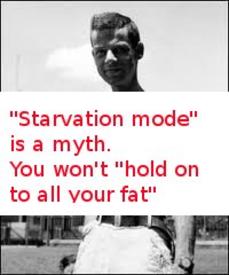We are pleased to announce that as of March 4, 2025, an updated Rich Text Editor has been introduced in the MyFitnessPal Community. To learn more about the changes, please click here. We look forward to sharing this new feature with you!
To eat or not to eat the extra calories you earn during work outs?
Replies
-
lemurcat12 wrote: »I eat a reasonable amount of them (I cut them to account for overestimates rather than relying on MFP -- I found Fitbit pretty accurate, though), but I move them over the week as a whole, as I may not be that much hungrier on a day I exercised a lot.
If you exercise hard, I'd definitely make sure you add to your calorie goal, as it is based on no exercise, and cutting too low can have negative effects, especially if maintaining muscle is a concern (as it is to me). I suppose if someone doesn't exercise that hard or much it doesn't really matter.fiddletime wrote: »I do a low estimate for weights and the lowest for cardio between my HRM and MFP. I eat them all back and have been losing 3# a month at 1200 calories and am close to GW after 6 months.
This is assuring. Thank you!
0 -
110 is pretty low unless your resting is way low too, you can just stop and take your pulse - I struggle to hold mine down at 120-130 riding at an average around 12 mph0
-
BuerreNoisette wrote: »I like the partial rule. If I go on a 40 o 50 mile ride and I'm burning 1200 calories during that time, eating that much food is sometimes difficult. ( in a healthy manner that is. I could eat a couple slices of pizza no problem, but I don't feel I'm doing myself any favors with that).
I think that I have a pretty good read on my body, as to when it needs those extra calories, but I absolutely don't want to lose all the muscle I've gained through strength training. That's a scary thought!
I notice that MFP seems to give me a lot of calories for doing exercise that I really don't think I'm working that hard at, such as walking. I bought a Bluetooth up3, which will arrive on Wednesday, and hope to get a more accurate calorie count with it.
Thanks for your replies. It's hard in losing the last 5-7 pounds of fat trying to lean out and expose the muscle without losing the muscle I worked 2 years to aquire.
I'm a cyclist...learning to properly fuel your rides is pretty important. Failure to do so ultimately result in performance issues as well as recovery issues and an increased risk of injury. Your fitness gains will also stall.
Think about it logically...your calorie targets are based on your day to day activity without any exercise...you're riding 50 miles which is a lot, and completely unaccounted for in your calorie targets. It makes perfect sense to account for that activity somewhere...you should do so either in your activity level (TDEE method) or by way of logging and eating those calories back (MFP Method...also called NEAT).0 -
After a couple months of figuring out what my actual burns are, I started eating 100% of them. Did not affect my weight loss nor has it affected my maintenance. It did greatly help my energy levels for my workouts.0
-
I try to nail down my actual calorie burns as close as possible, then eat pretty much all of them back. I do have days where eating them all back is just more eating than I want to do, so in that case I try to get enough to recovery properly and sometimes eat more the next day to aid in recovery.
When all is said and done, short of being a rolling lab experiment you can only get calorie burn calculations close, finding exacts is going to be tricky. But if you do some searching you can find better accepted formulas to compare to, and go from there.
I've quit using several apps due to grossly high calorie burn estimates, and don't use the standard MFP numbers for anything.
For a person eating at maintenance or a small deficit for weight loss, minor exercise that many log isn't going to hurt much if they don't eat it back. For people putting in an hour plus of decent exercise, it's quickly creating a deficit too large to be good for recovery or long term health most likely.0 -
I always ate back my exercise burn when I was losing. I really needed those extra cals to get a good workout without compromising my normal life ( being more inactive because I was tired).
I am petite and the burn MFP gave me for most cardio was pretty accurate 175 per hr, except it really overestimated Zumba.
I eventually worked out my own numbers and added 1300-1500 cals a week, about 200 a day to cover cardio and weight training.
I too found on the days I worked the hardest I tended to want less to eat so went by a weekly goal.
Cheers, h.0 -
cwolfman13 wrote: »BuerreNoisette wrote: »I like the partial rule. If I go on a 40 o 50 mile ride and I'm burning 1200 calories during that time, eating that much food is sometimes difficult. ( in a healthy manner that is. I could eat a couple slices of pizza no problem, but I don't feel I'm doing myself any favors with that).
I think that I have a pretty good read on my body, as to when it needs those extra calories, but I absolutely don't want to lose all the muscle I've gained through strength training. That's a scary thought!
I notice that MFP seems to give me a lot of calories for doing exercise that I really don't think I'm working that hard at, such as walking. I bought a Bluetooth up3, which will arrive on Wednesday, and hope to get a more accurate calorie count with it.
Thanks for your replies. It's hard in losing the last 5-7 pounds of fat trying to lean out and expose the muscle without losing the muscle I worked 2 years to aquire.
I'm a cyclist...learning to properly fuel your rides is pretty important. Failure to do so ultimately result in performance issues as well as recovery issues and an increased risk of injury. Your fitness gains will also stall.
Think about it logically...your calorie targets are based on your day to day activity without any exercise...you're riding 50 miles which is a lot, and completely unaccounted for in your calorie targets. It makes perfect sense to account for that activity somewhere...you should do so either in your activity level (TDEE method) or by way of logging and eating those calories back (MFP Method...also called NEAT).
Do you have any recommendations for fuel during cycling on my longer rides that is real food and not a gel or a gummy?0 -
macgurlnet wrote: »MFP is designed for you to eat those calories back.
However, many recommend eating a portion (between 25% and 75%) due to MFP overestimating the burns and giving you too many calories to eat back.
If you're doing strength training, I wouldn't log it. Log cardio (runs, walks, zumba, etc) and eat back 50% of those calories for 4-6 weeks and see how your weight loss goes.
If you don't eat back the calories, you risk having too high of a deficit, which in turn means you'll be undernourished. This can lead to more muscle loss, as well as other issues, like brittle nails and hair falling out.
This doesn't mean you have to eat back all of those calories on the day you earn them, though. When I'm running long distances, I'll have 2000+ calories to eat, and I may not be hungry enough for them that same day. I typically look at my calories over the course of a week and spread out those extras to other days.
~Lyssa
I mostly due strength training and I do log it, just like I log Yoga, Pilates, any cardio that I may do, and the ballet/barre exercises. If it is exercise and I burn something, I log it. I do know that this database inflates the calories burned (I don't use any kind of fitness tracker), so I chose to eat more if I am hungry; or like another poster wrote I use them as a "buffer." For me is more important to see the time that I spent working out than the calories themselves because being much older and a small person, I don't burn much.
Same here, I log strength training like anything else, and eat back a portion like I would anything else. It seems to be working since I lose at the rate MFP predicts. Strength training burns more calories than most people think due to the metabolic boost you get for ~24 hours afterwards.0 -
I usually eat about half of them as other have stated. I was using MFP burns for a while, and recently purchased a heart rate monitor as well. So far (7 months) I've lost roughly 2lbs per week. Occasionally more, occasionally less.0
This discussion has been closed.
Categories
- All Categories
- 1.4M Health, Wellness and Goals
- 394.5K Introduce Yourself
- 44K Getting Started
- 260.5K Health and Weight Loss
- 176.1K Food and Nutrition
- 47.5K Recipes
- 232.7K Fitness and Exercise
- 444 Sleep, Mindfulness and Overall Wellness
- 6.5K Goal: Maintaining Weight
- 8.6K Goal: Gaining Weight and Body Building
- 153.1K Motivation and Support
- 8.1K Challenges
- 1.3K Debate Club
- 96.4K Chit-Chat
- 2.5K Fun and Games
- 4.1K MyFitnessPal Information
- 16 News and Announcements
- 1.3K Feature Suggestions and Ideas
- 2.8K MyFitnessPal Tech Support Questions







